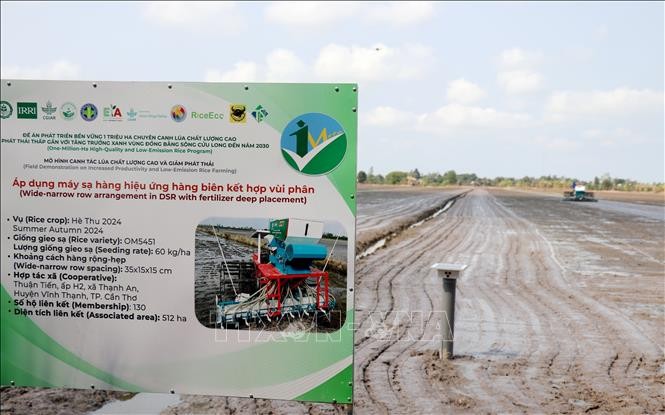(VOVWORLD) -The Ministry of Agriculture and Rural Development has launched a project to create one million hectares of high-quality, low-emission rice in Thach An commune, Vinh Thach district, Can Tho city. The project will restructure the entire rice industry of the Mekong Delta with the goal of reducing production costs and emissions, increasing the value of rice, and sustainably developing rural areas.
 A 50-ha pilot model of high-quality, low-emission rice field is grown by Thuan Tien Cooperatives in Can Tho city. (Photo: VNA) A 50-ha pilot model of high-quality, low-emission rice field is grown by Thuan Tien Cooperatives in Can Tho city. (Photo: VNA) |
The project is divided into two phases to be implemented in 12 Mekong Delta provinces and cities. In the 1st phase, from 2024 to 2025, the Ministry of Agriculture and Rural Development will pilot the project in Tra Vinh, Soc Trang, Kien Giang, Dong Thap, and Can Tho city.
In the 2nd phase, from 2026 to 2030, it will identify key areas for investment projects of new high-quality, low-emission rice varieties and will then expand to 820,000 hectares.
Le Thanh Tung, Deputy Director of the Plantation Department at the Ministry of Agriculture and Rural Development, said: “We want to show farmers, agricultural engineers, and international friends the results of the one-million-hectare high-quality rice project. It will minimize natural risks, create jobs, and raise farmers’ incomes.”
The pilot model in Can Tho city will adopt more sustainable rice farming methods, create large-scale, stable, high-quality raw material areas, and minimize environmental pollution.
Nguyen Ngoc He, Vice Chairman of the Can Tho municipal People's Committee, said: “Can Tho city pledges to make the project a success and combine it with the Mekong Delta’s green growth target. Can Tho is striving to create 38,000 hectares of high-quality rice by 2025, and 50,000 hectares from 2026 to 2030.”
The project will establish cooperatives and farmer organizations to closely collaborate with businesses to sustainably market the rice and increase farmers' incomes.